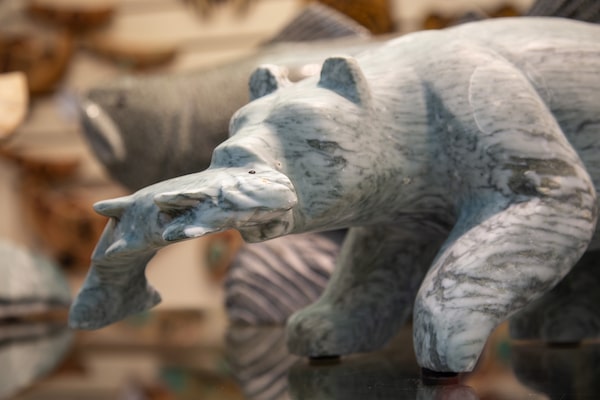
This carving at a shop in Ketchikan, Alaska, was made in the Philippines and engraved with the name of a nonexistent Tlingit artist, part of an operation that ran afoul of the U.S. Indian Arts and Crafts Act. The artist's two-year prison sentence is the longest of its kind in U.S. history.Photography by Nathan VanderKlippe/The Globe and Mail
The stone carving depicted a bear grasping a fish in its mouth, its supposed authenticity sealed with the engraved name of its Tlingit artist, Kilit. It was sold at a shop in Ketchikan that catered to the millions of cruise ship tourists who pass through this coastal town eager to bring home a piece of coastal Alaska. The price: US$3,200.
But Kilit did not exist, and the carving did not originate in Alaska. It was made in the Philippines, as part of a sophisticated operation that, for many years, stocked two shops in Ketchikan with humpbacks, bears, dolphins and eagles sculpted 10,000 kilometres away.
The arrest of the family accused of misrepresenting the sale of Indigenous-made goods, a violation of the U.S. Indian Arts and Crafts Act, marks a milestone in the prosecution of a crime that, for many decades, has had little enforcement. It comes at a moment when Indigenous groups in the United States are taking new interest in enforcing artistic traditions they see as their intellectual property, with lucrative potential.
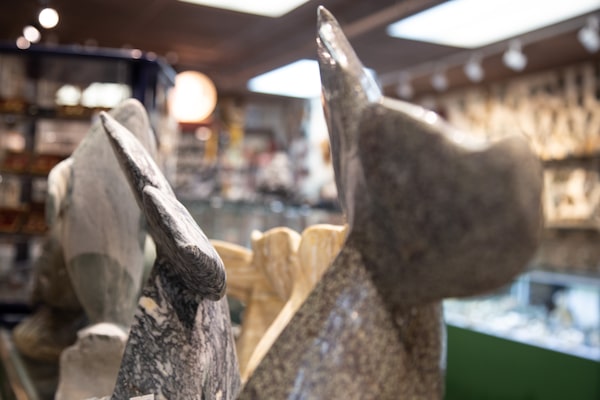
Artworks like the ones sold in Ketchikan have become test cases for how to enforce U.S. laws around Indigenous craftsmanship.
The case has underscored the potential effectiveness of a unique U.S. law designed to protect Indigenous-made art, a law nearly a century old.
It has also brought to the fore the complexity of enforcing rules based on artistic identity, and the limitations of legislation without enforcement.
According to the U.S. Attorney, Cristobal Rodrigo, the real identity behind Kilit, began to teach Alaskan art styles to Filipino artists beginning a quarter-century ago, in 1998. He and his wife, Glenda, then formed a company in the Philippines that manufactured carvings and totem poles and shipped them to the U.S., where his store staff told customers, including undercover federal agents, they were made by local artists.
The stone was marble rather than soapstone, the wood mahogany instead of cedar. But the designs were often well crafted, and the price negotiable. Tourists bought pieces by the hundreds.
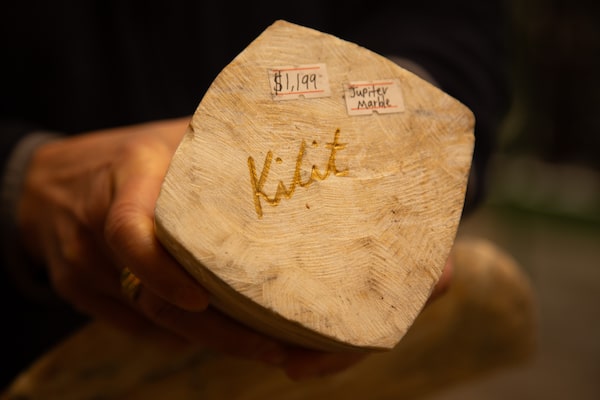
U.S. authorities discovered that 'Kilit' is a pseudonym for Cristobal Rodrigo, who is now serving prison time.
Mr. Rodrigo is now serving a two-year sentence in an Oregon prison, in what the U.S. Justice Department called a “monumental sentence” that is the longest of its kind in U.S. history. His wife and son, Christian, await sentencing later this year. An employee, Jessie Reginio, was ordered to pay a fine for calling himself an Indigenous carver named Sonny. At least three others have been charged.
“It’s good to see the powers of the state are being activated, as they should have been for almost 100 years now, to use this law,” said Jacob Adams, an attorney who has worked with Sealaska Heritage Institute, a non-profit dedicated to furthering the cultures of Alaska’s Tlingit, Haida and Tsimshian people.
“It’s nice. Is it making an impact on the market? No.”
The drafters of the U.S. Indian Arts and Crafts Act, first enacted in 1935, were concerned that rampant theft of Indigenous designs and motifs could “lead to the loss of entire peoples and cultures. And that’s not hyperbole,” said Mr. Adams. The law, updated in 1990, mandates truth in advertising: Art must be made by Indigenous hands if it is marketed that way.
For much of its existence, however, it has been little enforced. A 2011 report by the U.S. Government Accountability Office found that from 2006 to 2010, 649 complaints were made to the Indian Arts and Crafts Board, which concluded that 150 appeared to be violations of law. It referred 117 of those to law enforcement, “but no cases were filed in federal court as a result.” No one knows the size of the market for such art, nor the extent of misrepresented works, the report found.
The years since have brought some new enforcement. In 2019, two men in Albuquerque, N.M., pleaded guilty to selling jewellery fashioned in the Philippines and agreed to US$300,000 in fines, as well as community service hours. In 2021, a Juneau man forfeited carvings worth more than US$1.5-million and was fined for selling Philippines-made art. Last year, a man selling art near Seattle’s Pike Place Market was sentenced to 18 months of federal probation after misrepresenting himself for a decade as a member of the Nez Perce peoples.
Indigenous organizations have contemplated more assertive action. Sealaska is moving toward an “offensive approach,” said Lee Kadinger, the institute’s chief operating officer. Lawyers have begun to examine the potential for trademark and copyright claims to certain designs. Civil suits, however, can be expensive.
Building recognition of intangible properties amounts to a new frontier in assertion of Indigenous rights. First came steps to secure land and resources. “But there’s only so much land. There’s only so much natural resources,” Mr. Adams said. Indigenous intellectual property – culture and artistic traditions – provides the potential for “unlimited economic growth and economic foundation for Indigenous groups.”
But fakes, like those that were being sold in Ketchikan, have proliferated. Mr. Rodrigo, according to a charging document, formed a company in the Philippines in 2003 to manufacture carvings. Work on the totems began in 2015. The family did a robust business. The imported carvings were cheap, but sold for thousands. In one year alone, they made at least US$1-million in sales, according to Assistant U.S. Attorney Jack Schmidt.
Other local vendors were furious, but powerless. “Look at the money he’s making. Unbelievable profit margin there, it’s hard to fathom,” said Michael Peters, who owns Scanlon Gallery in Ketchikan. It features works from 120 Indigenous artists.
Indigenous art sales in southeastern Alaska total tens of millions of dollars a year, Mr. Schmidt told the sentencing hearing last year for Mr. Rodrigo. But knockoffs are “way more widespread than your typical white-collar offence,” he said. “Half the businesses probably misrepresent at some point or another to make a sale.”
At the hearing, Richard Peterson, president of the Central Council of the Tlingit and Haida, removed his shirt to show his traditional tattoos. “This tells you who I am,” he told the court. “Our art is everything to us. It’s not just symbols. They are not just items.”
Tlingit totem carver Wayne Price, who teaches at University of Alaska Southeast, was among those who spoke to the court. The visual traditions of the northwest peoples are “hallowed ground,” he said in an interview. “Our art is our culture and it belongs to us.” Yet deciding who can legitimately make that art, he said, is not simple. His students include people who are not Indigenous. “I know a lot of non-natives doing art, and they’re my friends. We’ve done a lot of art together. Is that right or is that wrong?”
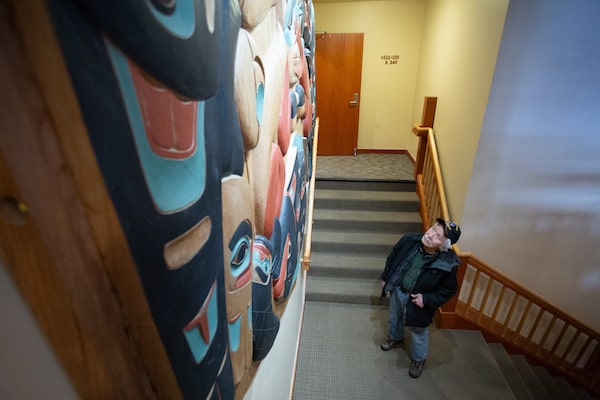
Nathan Jackson designed this cedar panel in Ketchikan, where he lives. The Tlingit artist is wary about using a standard of Indigenous identity to police other artists: 'I can’t be discriminatory and I would like to stay that way.'
In Ketchikan, the Totem Heritage Center displays work by Nathan Jackson, a Tlingit man who lives in Ketchikan and is celebrated as one of Alaska’s most influential Indigenous artists. It also includes an intricate Chilkat robe woven by Mr. Jackson’s wife, Dorica. She is not Indigenous, but is credited with being one of the first contemporary weavers to complete such a robe, at a time when that art form was considered all but extinct.
Mr. Jackson, 85, has personal experience with fakes. Counterfeit jewellery bearing his name has appeared in Ketchikan. Early in his career, he remembers trying to sell small totem poles to shops, only to be turned away. His finely-honed creations were too expensive and so well-crafted they made other work look bad.
“It was a lot of trials trying to do my own work,” he said. Years later his art, now coveted, is displayed at the local airport, on city property, in totem parks and in local hotels.
Yet he preaches caution about aggressively targeting work produced by people based on meeting a standard of Indigenous identity. One of his own ancestors is Black. “I can’t be discriminatory and I would like to stay that way. Because to me, it makes sense to not stir the water,” Mr. Jackson said. “For me, it’s one of those things where you wrestle water, it gets pretty rough.”
Even sales staff selling Mr. Rodrigo’s Philippines-made art were native Alaskans.
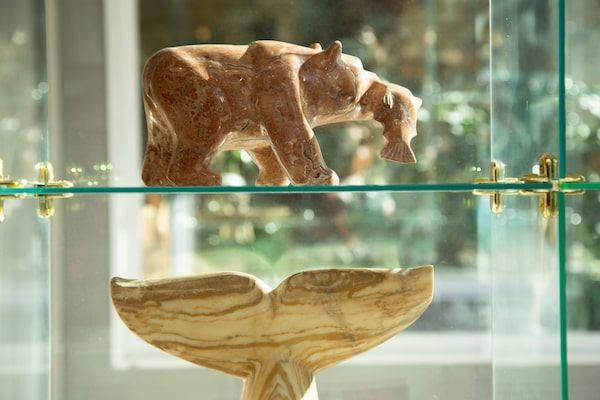
Filipino-made art is still available at Ketchikan stores, though explaining their real origin is likely to reduce the chance of a sale.
The family’s two Ketchikan stores are now closed. Some of their art, however, remains on display. At Tom’s Treasures, bears and whale tail carvings sit on glass shelves, some signed with the false Kilit name used by Mr. Rodrigo.
Shop owner Tam Rayner is quick to tell a visitor they are made in the Philippines, saying Mr. Rodrigo fooled her, too, about their origins. If she lies about where they come from, “I’m finished,” she said. But customers lose interest when they discover the pieces are foreign-made.
“I can’t sell them,” Ms. Rayner said.
Ken Decker, a Tsimshian carver who owns the Crazy Wolf Studio down the street, welcomes the scare caused by recent enforcement, although he doubts it will last. “As soon as things cool off, people will go back to their old ways again,” he said.
He regularly confronts inauthentic art, often in the hands of customers demanding to know why his goods, like the drum he was painting on a recent afternoon, are so much more expensive.
“It’s killing me, all that fake stuff,” he said. “There’s so much junk out there.”
Ken Decker paints a drum at the Crazy Wolf Studio in Ketchikan store, where he has to field quetions about why his wares are more costly than inauthentic art. 'It's killing me, all that fake stuff,' he says.
 Nathan VanderKlippe
Nathan VanderKlippe